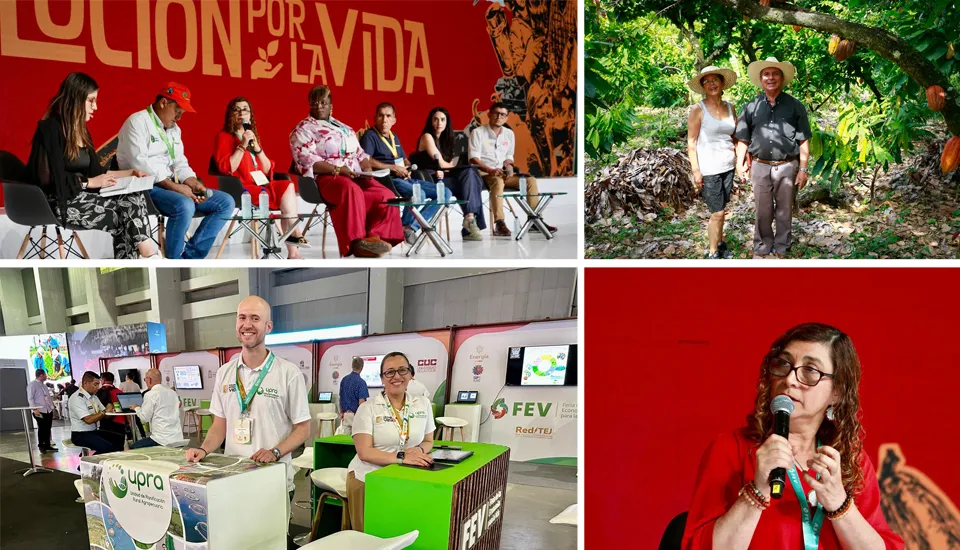 4/10/2024
4/10/2024
At the Economies for Life fair, UPRA showcases the productive potential of Peasant Agriculture, cacao cultivation, and sustainable livestock models

In 14 million hectares of national territory, ACFEC is present, producing 70% of the food consumed in the country.
Through crop monitoring, UPRA tracks the hectares planted with cacao in the country.
Reducing greenhouse gases related to livestock: one of the challenges facing the agricultural sector in Colombia.
Barranquilla, Atlántico (@UPRAColombia, @Dorairey). Under the premise of transitioning from extractive economies to economies for life, where Peasant, Family, Ethnic, and Community Agriculture (ACFEC) is the central axis of agricultural policies, the "Economies for Life" fair is taking place in Barranquilla, Atlántico. Organized by the national government, the fair presents to the international community a portfolio of projects focused on energy and climate transition, industrialization, and economic recovery.
In this context, the Rural Agricultural Planning Unit (UPRA) participated in the panel "Industrialization and Environmental Sustainability in Peasant, Family, Ethnic, and Community Agriculture," where Dora Inés Rey Martínez, acting director-general, explained: "The entity has been supporting the Ministry of Agriculture with inputs such as the text Characterization and Typologies of Peasant, Family, and Community Agriculture with an Agrobio-cultural Approach: Policy Recommendations (2024), where we highlight the location and number of plots dedicated to this purpose, totaling over 14 million hectares of national territory. Thus, ACFEC plays a significant role in food production; UPRA studies show that 70% of the food consumed in the country comes from ACFEC."
22% of ACFEC is dedicated to self-consumption, while 78% has already opened national and international markets. The main challenges for ACFEC are to strengthen production and add value to ensure markets. Local public purchases are an option: government entities could purchase ACFEC products. It was also noted that formalizing property ownership is not enough; access to rural public goods, including the development of access roads, is necessary. Lastly, it was reported that UPRA is supporting the Ministry of Agriculture in formulating the National Agroecology Policy.
The entity has made available for consultation and download, on its website, the document on ACFEC, which outlines its main characteristics: degree of industrialization, market involvement, labor, and technology use. Additionally, the Characterization of Rural Producers (2020) text provides an analysis of the issues facing these producers, categorized by population groups such as peasants, Indigenous peoples, Afro-descendants, and amphibious communities, which have been marginalized in public policy design.
Links to the referenced publications:
https://upra.gov.co/es-co/Publicaciones/caracterizacion_agricultura_campesina_familiar.pdf
https://upra.gov.co/es-co/Publicaciones/01_CaracProduc_.pdf
UPRA also participated in the panel "Economic and Social Potential of Cacao Production," where Alexander Rodríguez, Technical Director of Efficient Use of Rural Land and Land Improvement, explained the programs and projects associated with the Cacao Value Chain Productive Zoning Plan (POP) and its Agroindustry. This 20-year initiative involves more than 65,000 producers, 95% of whom are small producers participating in ACFEC.
"Colombian cacao is valued for its flavor and aroma; it is one of the 11 countries in the world classified as 'fine aroma' cacao. We now have a major commitment to the European Union defined through the Green Pact. In this regard, it is essential to demonstrate that Colombia exports cacao from areas that have not been deforested." He also highlighted that the POP proposes monitoring crops with satellite images to identify the number of hectares planted and, together with EVA (Environmental Valuation Areas), unify figures on this crop.
In summary, Rodríguez stated: "Currently, there is an excess of global demand for cacao, which is very positive for producers. Cacao is easy to transport, acts as a carbon sequester, preserves soils, provides an alternative to illicit crops, and is common in ACFEC. Thus, promoting its cultivation is a way to improve the quality of life for these producers. It is a crop with significant environmental benefits, making it suitable for productive conversion processes."
Consult documents related to the cacao POP at the following link: https://upra.gov.co/es-co/Paginas/pop-cacao.aspx
Finally, Emiro Díaz Leal, UPRA's Planning Advisor, presented two projects related to sustainable production models for meat and dairy cattle, which emerged from the POPs of these value chains formulated by the entity and delivered to the Ministry of Agriculture. "These projects aim to implement sustainable models for milk production in 10 regions of Colombia and meat production in 7 regions. UPRA's contribution is significant in highlighting efficient land use linked to livestock, as more than 86,000 families benefit from dairy production and 72,000 from meat production." The goal is to improve productivity, but above all, to maintain ecosystem services, environmental policies, sustainable agriculture, and reduce greenhouse gases associated with livestock production.

